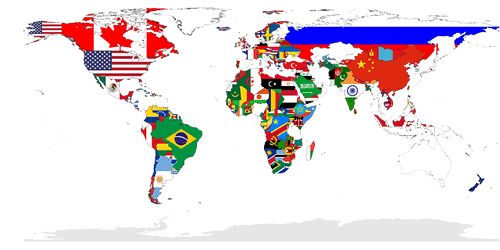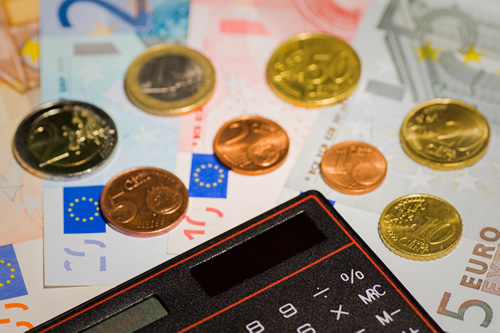Budget
Travel Abroad: The
Ultimate Checklist
By Rob Sangster

Picture yourself in the legendary Ngorongoro
Crater in Tanzania just after dawn, sitting in the wicker
basket of a red and yellow striped balloon. After chuff-chuff-chuffs
from the burner fill the balloon with hot air, you ascend
slowly, sipping chilled champagne as you watch lions, rhinos,
and elephants drift past on the savannah below. Now picture
yourself left behind, standing on the floor of the crater
gazing up with envy, wishing you’d budgeted money
for this adventure.
As college-age backpackers, many of us traveled on a bare-bones basis and kept going until our money ran out. That sort of trip required eating on the margins of nutrition and hygiene, occasionally living in barely habitable accommodations, and foregoing most treats. Sound like fun? It was back then, but now time, health, and love of adventure are more important than a few dollars. After all, one reason to travel is pleasure. If you make informed choices, bargain a bit, and skip overpriced tourist frills, you can easily have a fine trip within a reasonable budget, including hot air balloon rides.
Most people are about as fond of figuring budgets as calculating their taxes. But, as with taxes, you'll pay a penalty if you don't do it right. Let's find out how it's done, as we will supply a budget travel checklist at the end of this piece.
Norway isn’t Guatemala

We'll begin by acknowledging one of life's realities: travel costs vary wildly worldwide, and your choice of destinations must consider this. Travelers may write off Japan, some of Europe, and other high-cost destinations whenever the dollar loses its value as a currency, no matter the cause. Editor's Note: As of 8/2023, the dollar is robust, and travel and living abroad is often much cheaper almost everywher
A week touring Norway can easily
cost more than a month in Guatemala. Fortunately much
of Latin America is a relative bargain, even inexpensive
(see Numbeo.com for
a crowd-sourced estimate of cost for a given country).
But there are still enormous cost variations between,
for example, a highly-promoted Mexican beach resort,
a Brazilian metropolis, and a Nicaraguan seaside village.
The cost of travel in a given
country also depends in part on the strength of your
currency in relation to that country’s. In the
1960s, when the U.S. dollar had some muscle, Europe on
$5 a day was very possible. Today, when a martini can
cost $25 in some European capitals, imagine what you’d
spend for a serious night on the town.
A nice 3-star double hotel room
is easy to find for $50 in Antigua, Guatemala, but you’d
pay that in Amsterdam or London for two dorm beds in
a hostel. That $10 taxi ride from the airport in Mérida,
Mexico will run more than $100 in Madrid. A haircut that
costs $5 in Colon, Panama costs $65 in Tokyo. A simple
fast food meal that costs only $4 in Mexico City will
zap you for over $20 in Oslo.
The Accountant’s Travel Budget
Which is the chicken; which is the egg? Do you plan your trip by choosing a destination first or start by drafting a budget? That’s a trick question. Obviously, the destination matters most, so if money didn’t matter, that’s what you’d focus on first. But if money does matter, you’ll have to bother with a budget. One way to draft your budget, perhaps the one a responsible accountant might calculate, is to choose the maximum amount you’re comfortable spending on a trip. Then bump that up a bit because of all the money you won’t spend at home on food, entertainment, utilities, etc.
Suppose you choose to spend $3,000, and your roundtrip transportation will cost $1,000. That leaves you $2,000 to spend “on the ground.” Use the checklist (see box-out below) to estimate local daily costs and divide that into $2,000. If that allows you 14 days, great. But what if it permits only eight days, and that’s not enough time to see everything you want to see? Does that mean you’re condemned to yet another trip to Florida?
The Romantic’s Travel Budget
Not at all — because there’s another way to approach a budget, one a romantic would prefer. Choose your favorite destination and determine how many days it will take to experience everything on your “must-see” list. Next, use the checklist to calculate how much that number of days will cost. Now persuade yourself to spend that amount. If you can’t make the case, or the cupboard is too bare for the grandest scheme, cut back on the level of accommodations and class of tickets, and figure out which areas or attractions you can cut — until you have a cost you can live with. The romantic will find a way to afford what they want.
Constructing a Travel Budget

List all the things you expect to spend money on, then plug in the length of the trip and local cost estimates. Let’s practice by assuming certain expenses for a hypothetical 30-day trip in Central America:
1. Pre-departure expenses. These
include the cost of visas, photographic equipment, medical
protection (e.g., shots, prescription, and over-the-counter
medicines), guidebooks and travel apps, new clothing,
gear, and travel insurance (you can risk not going with insurance, but I would not suggest doing so). Let’s estimate pre-departure expenses
for this trip at $450. We will assume you have a laptop
if you want to bring one along.
2. Airfare. Assume
a cost for airfare (getting there, traveling around,
and returning home) of $1,000.
3. Other transportation. Such forms include local buses, taxis, and other non-air transport. Your working itinerary shows how often you’ll need local transport, and guidebooks give you a reasonable idea of the costs. Estimate $200.
4. Lodging and meal
expenses. The best cost estimates come from
the internet, current guidebooks, and from people
who’ve recently returned from your destinations.
Of course, before you’re there, it’s hard to know exactly how much you have to spend for meals and lodging that will make you happy. Nevertheless, here’s the process for estimating these costs for a 30-day trip to Central America.
- Subtract the days when you’ll pay no separate charge for lodging, such as when you’ll be trekking or on an overnight plane or train. Let’s say there are five of those days, leaving 25 days. An average cost of $50 per day (easy to do in Central America) times 25 gives you $1,000. Adjust that upward by 15 percent to cover price escalation, an occasional splurge, and budget $1,150 for lodging.
- An average expense of $20 per day for meals times 30 gives you $600. Adjust that upward by 15 percent and budget $690. Remember that you’d spend at least that much in 30 days at home.
5. Special experiences. Paying for special experiences can ravage your budget if you don't plan for them. I'm referring to the cost of scuba diving, sailing, trekking, rafting, etc. Most of these opportunities will surface during your research, but you won't recognize some as "musts" until you reach your destination.
How much do these exceptional experiences cost? Check the Internet and guidebooks, call national tourism offices, and ask a knowledgeable travel agent or someone who has been there recently. If you need help to turn up something, take a guess.
I suggest three rules of thumb:
- Extraordinary experiences in developed countries cost more than you might expect, and in developing countries, even less than you might expect
-
If modern technology is involved, such as a helicopter, they'll be pretty expensive
-
Prices quoted by a travel agent for extraordinary experiences will almost certainly be higher than you'll pay if you make your arrangements abroad
For our hypothetical trip, assume
four days of scuba diving and several day trips with
guides. Estimate $550.
6. Miscellaneous. This
category includes odds and ends: clothing you buy on
the road, souvenirs, toiletries, beverages, books, postcards,
postage, tips, etc. Your estimate here is a matter
of personal preference and available money. Whatever
you estimate, add 25 percent. For this hypothetical trip,
budget $400.
If you want to fine-tune your budget, find out whether your currency has grown significantly stronger or weaker since the information you rely on was published. Check the web for your favorite of the many currency converters and consult crowd-sourced expense websites such as see Numbeo.com.
To be even more conservative,
add up all the categories and an additional 15%
to the total to cover surprises and spontaneous splurges.
Don't skip a beat if the grand total is more money than you have. The purpose of your estimated budget is to simulate reality ahead of time and to notify you that you have to cut some expenses or redesign the trip.
In summary, avoid a bare-bones budget if you can. Leave room for decent food and shelter, small pleasures, and exceptional experiences. Before you cut back on your trip, consider investing more in your lifelong memories.
Checklist for Building
Your Travel Budget
| Pre-Departure
Expenses |
| $___________passport,
visas, and photos |
| $___________health care
(medicine, immunization) |
| $___________guidebooks |
| $___________reading
material |
|
$___________camera,
other photo equipment, unless you only use your phone
|
|
$___________luggage,
daypack
|
| $___________new clothes |
| $___________travel
insurance |
| $___________gear (binoculars,
money belt, etc.) |
| $___________toiletries |
| |
| Transportation |
| $___________airfares |
| $___________airport
parking |
| $___________checked
baggage fee |
| $___________other (trains,
buses, car rentals, gas, etc.) |
| |
| Communication |
| $___________telephone
charges (SIM card, temp phone, etc.) |
| |
| Meals and Lodging |
| $___________en route |
| $___________daily lodging |
| $___________daily meals |
| |
| Special
Experiences |
| $___________cultural
activities such as museum tickets, concerts, tours, siteseeing |
| $___________entertainment / nightlife |
| $___________adventure
activities such as scuba diving, rafting,
etc. |
| |
| Miscellaneous |
| $___________souvenirs,
gifts, tips, laundry |
| $___________currency
exchange, bank fees |
| |
| Your Own Additional Miscellaneous
Expenses |
|
$___________
|
| $___________ |
| $___________ |
| |
| Total Trip Budget |
| $___________subtotal |
| $___________add 15% for unexpected |
| |
| $___________Total |
|
ROB SANGSTER’s Traveler's
Tool Kit: How to Travel Absolutely Anywhere is
essential reading for those setting out to see the world.
It contains more than 500 pages of Rob’s road-tested
information and advice on every aspect of independent world
travel. When not traveling Rob writes and sails in LaHave,
Nova Scotia, Canada. See his bio for
his books and more articles written for Transitions Abroad.
| Related Topics |
| Budget
Travel |
|
